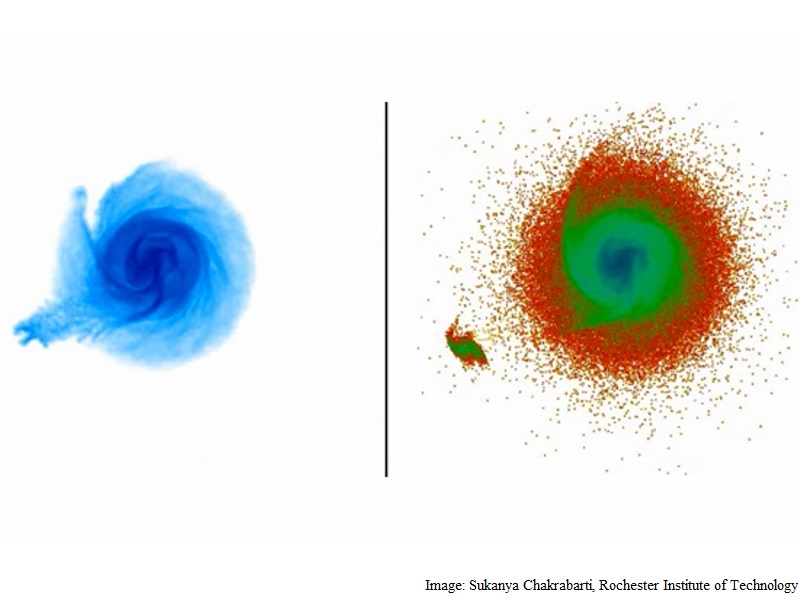- Home
- Science
- Science News
- Professor Develops New Method to Hunt Dark Matter
Professor Develops New Method to Hunt Dark Matter

Sukanya Chakrabarti, assistant professor at Rochester Institute of Technology in New York, uses waves in the galactic disk to map the interior structure and mass of galaxies - like seismologists analyse waves to infer properties about the Earth's interior.
Her team used spectroscopic observations to calculate the speed of the three Cepheid variables - stars used as yardsticks to measure distance in galaxies - in the Norma constellation.
Chakrabarti used Cepheid variables to mark the location of a dark-matter dominated dwarf galaxy approximately 300,000 light years away.
In contrast, the disk of the Milky Way terminates at 48,000 light years.
"The radial velocity of the Cepheid variables is the last piece of evidence that we've been looking for," Chakrabarti said. "You can immediately conclude that they are not part of our Galaxy."
Invisible particles known as dark matter make up 85 percent of the mass of the universe.
"The mysterious matter represents a fundamental problem in astronomy because it is not understood," Chakrabarti added.
Her method for locating satellite galaxies dominated by dark-matter taps principles used in seismology to explore the interior of the galaxy.
"We have made significant progress into this new field of galactoseismology where by you can infer the dark matter content of dwarf galaxies, where they are, as well as properties of the interior of galaxies by looking at observable disturbances in the gas disk," Chakrabarti explained.
This new method to characterise dark matter marks the first real application of the field of galactoseismology.
"It is very similar to seismology in a sense because we're trying to infer things about the interior of galaxies and how much dark matter there is and how much there has to be to produce these disturbances," she pointed out.
The study further questions the standard paradigm that old stars populate the dark matter halo and young stars form in the gas-rich stellar disks.
Chakrabarti's findings have been submitted for publication in Astrophysical Journal Letters.
Get your daily dose of tech news, reviews, and insights, in under 80 characters on Gadgets 360 Turbo. Connect with fellow tech lovers on our Forum. Follow us on X, Facebook, WhatsApp, Threads and Google News for instant updates. Catch all the action on our YouTube channel.
Related Stories
- Samsung Galaxy Unpacked 2025
- ChatGPT
- Redmi Note 14 Pro+
- iPhone 16
- Apple Vision Pro
- Oneplus 12
- OnePlus Nord CE 3 Lite 5G
- iPhone 13
- Xiaomi 14 Pro
- Oppo Find N3
- Tecno Spark Go (2023)
- Realme V30
- Best Phones Under 25000
- Samsung Galaxy S24 Series
- Cryptocurrency
- iQoo 12
- Samsung Galaxy S24 Ultra
- Giottus
- Samsung Galaxy Z Flip 5
- Apple 'Scary Fast'
- Housefull 5
- GoPro Hero 12 Black Review
- Invincible Season 2
- JioGlass
- HD Ready TV
- Laptop Under 50000
- Smartwatch Under 10000
- Latest Mobile Phones
- Compare Phones
- Redmi Note 15 5G
- Redmi Note 15 Pro 5G
- Redmi Note 15 Pro+ 5G
- Lava Play Max
- Poco C85 5G
- Honor Magic 8 Lite
- Jolla Phone
- Realme P4x 5G
- Asus ProArt P16
- MacBook Pro 14-inch (M5, 2025)
- OnePlus Pad Go 2
- Poco Pad M1
- Just Corseca Skywatch Pro
- Honor Watch X5
- Acerpure Nitro Z Series 100-inch QLED TV
- Samsung 43 Inch LED Ultra HD (4K) Smart TV (UA43UE81AFULXL)
- Asus ROG Ally
- Nintendo Switch Lite
- Haier 1.6 Ton 5 Star Inverter Split AC (HSU19G-MZAID5BN-INV)
- Haier 1.6 Ton 5 Star Inverter Split AC (HSU19G-MZAIM5BN-INV)

















